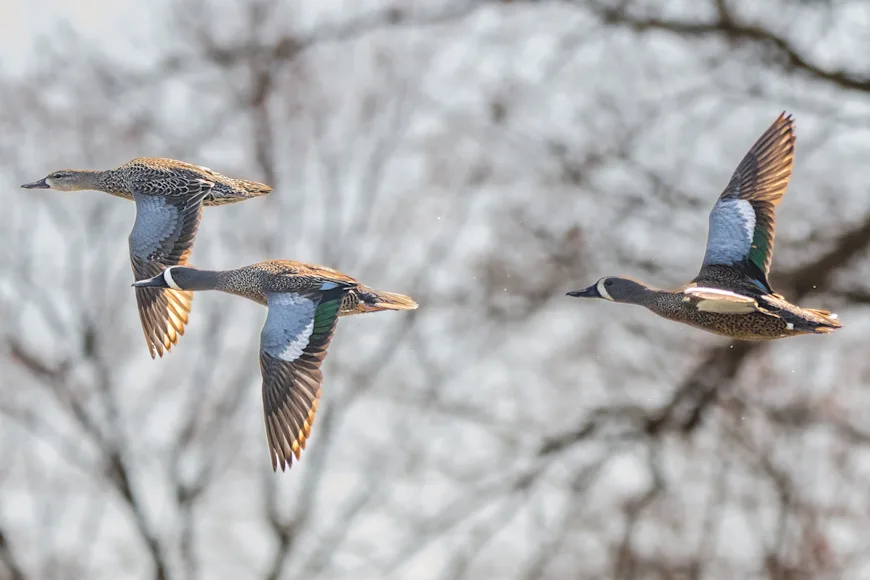On August 20, the United States Fish & Wildlife Service (USFWS) released its 2024 Waterfowl Breeding Population and Habitat Survey. Widely recognized as the world’s gold-standard wildlife survey effort, the annual duck count helps determine bag limits for upcoming waterfowl seasons throughout the U.S. and Canada by tallying up waterfowl numbers and the number of ponds present in key breeding habitat. This year, surveyors estimated a total of 34 million breeding ducks from western Alaska to the central Great Lakes region—a 5 percent increase over numbers gathered during last year’s survey efforts. They also counted 5.2 million ponds in the Prairie Potholes, up 4% from the 2023 estimate of 5 million.
In a press release highlighting key takeaways, Ducks Unlimited showed how some of the most popular duck species fared in the 2024 Waterfowl Survey. Most notably, mallard, wigeon, and green-wing teal numbers were on the rise on the western half of the continent, which the survey referes to as the "traditional survey area." The mallard population in those areas climbed by 8 percent and wigeons by a whopping 55 percent. Green-winged teal numbers were up 20 percent since 2023, and the scaup population jumped by 16 percent.
“This year’s report suggests that some duck populations had better production last year than expected, with good carryover to spring of this year,” said Dr. Steve Adair, Ducks Unlimited Chief Scientist. “While estimates were down in the prairies, population levels were up in northern breeding regions. We heard reports of an early spring, with ducks migrating through when the prairies were still dry and likely overflying to the Boreal Forest. This is a pattern we’ve seen many times before, and it appears to have been the case again this year.”
Early Teal Seasons Could Be Shortened—But Pintail Bag Limits Might Increase
Other species in the traditional survey area showed less encouraging population numbers. Northern pintails and gadwalls, for example, decreased by 11 percent. Canvasbacks dropped by 8 percent, redheads by 16, and blue-winged teal by 12 percent.
In the eastern survey area, stretching from the central Great Lakes to the far-eastern edge of Newfoundland, mallards showed a decline of 4 percent, while American black duck numbers increased by 17 percent, green-winged teal by 20, and goldeneyes by a full 42 percent. Wood duck numbers, on the other hand, fell by 10 percent in the east.
With a 12 percent drop in blue-winged teal numbers—to an estimated population of 4.6 million birds in the traditional survey area—hunters are likely to see changes to their early teal seasons. “The recommended regulation for early teal season in 2025 … will be a 9-day season with a 6-bird daily limit,” DU reported in its press release, adding that "the new recommendations won’t affect season lengths and bag limits for 2024."
Early teal seasons open in September. In recent years, the early duck season—particularly popular in southern states like Texas, Arkansas, and Louisiana—has run for a total of 16 days. USFWS guidelines established in 2014 allow for the 16-day seasons in the Central, Mississippi and Atlantic flyways when the population estimate is above 4.7 million, DU says. But the shorter 9-day season is triggered when the population drops below that 4.7-million-duck threshold.
The northern pintail bag limit, on the other hand, could soon jump from 1 bird per day across all flyways to a three-birds-per-day limit per hunter. This would be the first time waterfowlers have had the opportunity to bag three pintails in one outing since 1997. Those proposed changes are based on new findings that indicate that hunter harvest has negligible impact on pintail populations, so long as the birds have access to adequate breeding habitat in Canada.
Read Next: The Best Goose Calls of 2024
“North American waterfowl are arguably the most intensively studied group of animals on the planet, and the Adaptive Harvest Management process continues to be the gold-standard for modern wildlife harvest management,” Adair said. “We express gratitude to our state and federal partners for their reliance on clearly defined objectives and science-based decision making to guide harvest regulations, ensuring waterfowl populations remain healthy and available for enjoyment by many generations to come.”


